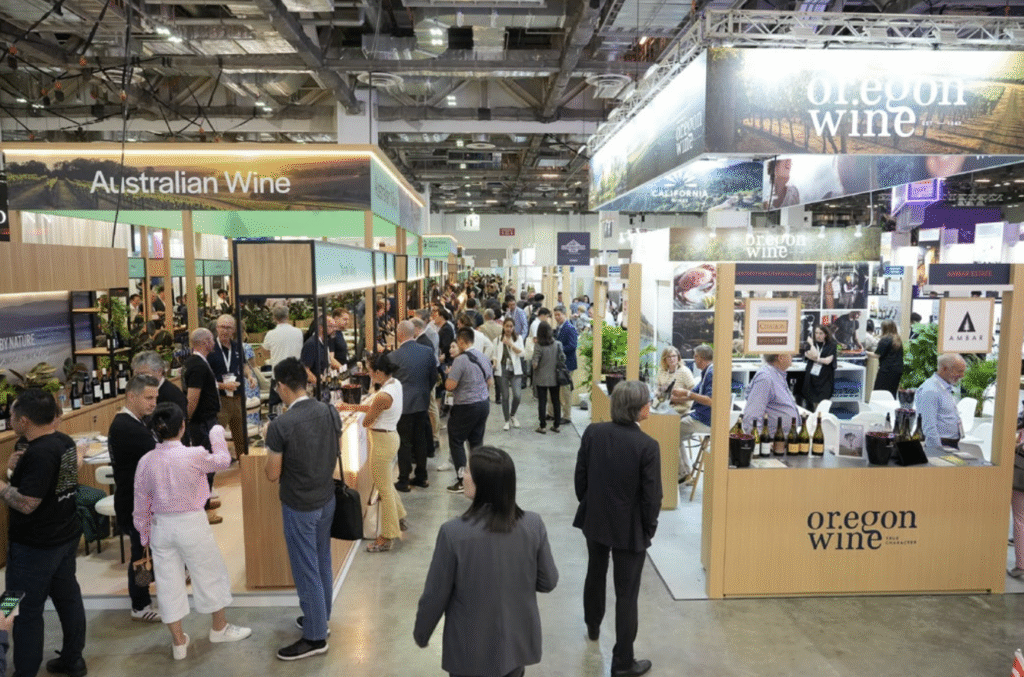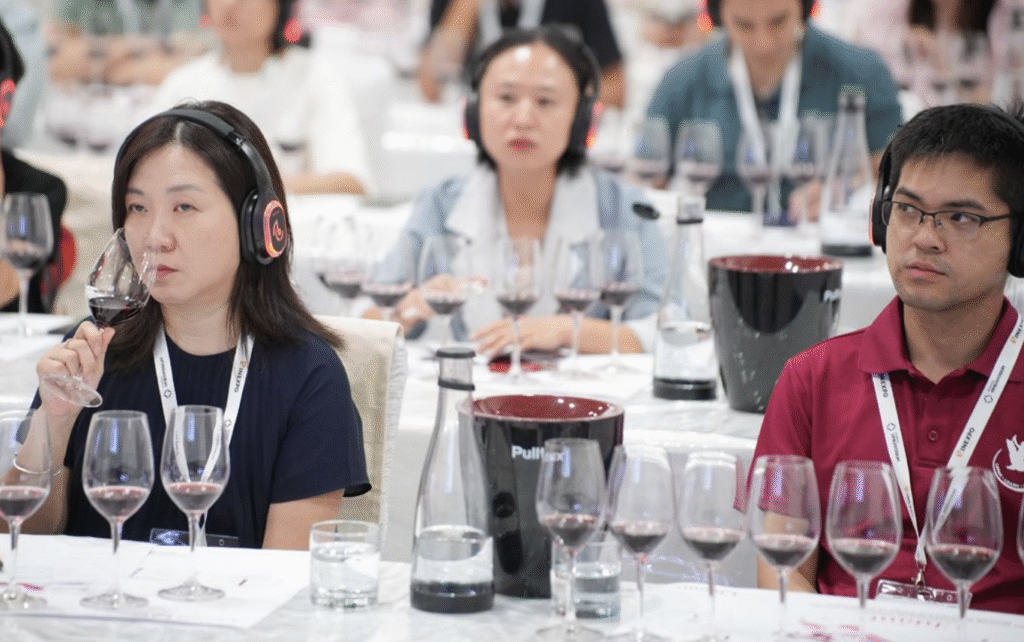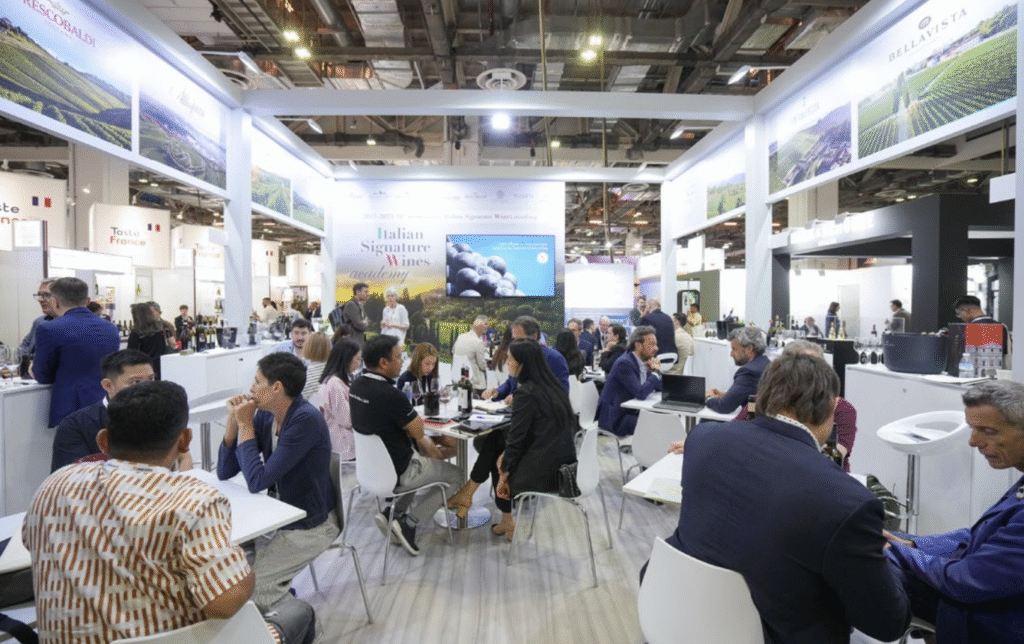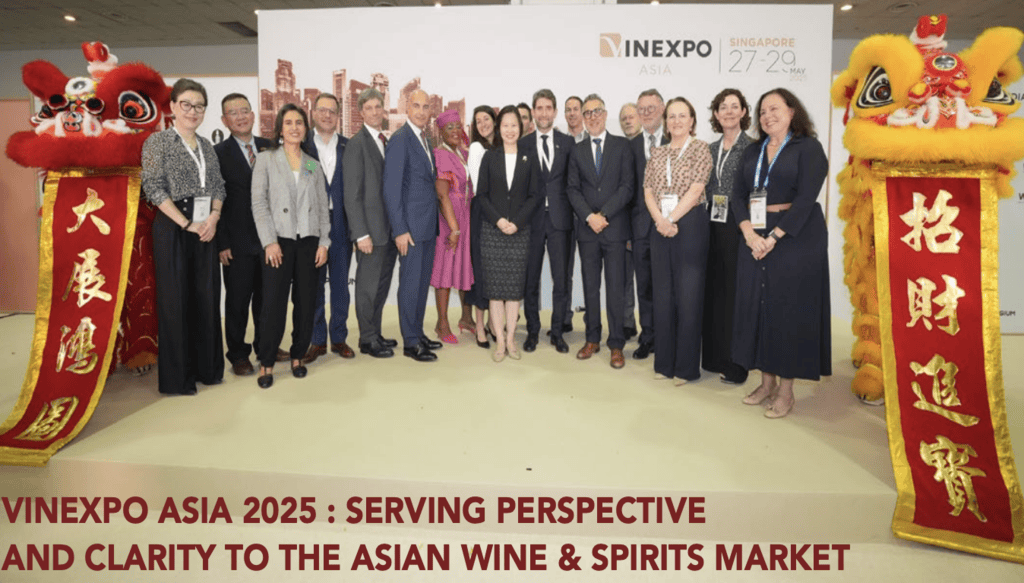
Malay Kumar Rout
The founder of WSCI (Wine & Spirits Club of India)
Providing clarity to the wine and spirits industry
through Vinexpo Asia 2025 highlights the
importance of transparency and coordinated
action in the global environment that is constantly
influenced by political, climate, and economic
trends. Held with tremendous success from May
27 to 29, 2025, at the world-famous Marina Bay
Sands in Singapore, the event cemented its
position as both a powerful commercial
accelerator and a strategic venue for market
orientation and group understanding.
Proving its ongoing relevance and appeal, the
2025 edition drew an incredible 8,998 trade
attendees. Under Singapore’s Minister of State
for Foreign Affairs and Trade and Industry, Gan
Siow Huang, and 15 ambassadors, the opening
ceremony quickly underlined the event’s deep
roots in economic diplomacy and its ongoing
commitment to support free and open trade
concepts. This top-level endorsement created a
bright ambiance for the three-day exhibit.
Rodolphe Lameyse, CEO of Vinexposium,
remarked “Today, Southeast Asia stands out as
one of the most exciting growth engines for our sector. That’s why Vinexpo Asia matters. Because
this is not just where the market meets; it’s where
strategies are shaped. Vinexpo Asia brings
international producers closer to the pulse of
ASEAN markets a region that’s fast becoming
central to the future of our industry.”
This
statement precisely expressed Vinexpo Asia’s
main objective: to go beyond the typical trade
show format and turn into a strategic engine, a
vibrant corporate accelerator, and an
all-encompassing knowledge hub. It created an
atmosphere wherein possibilities not only
appeared but also actively came together into
concrete results, so driving growth and drawing
attention to the most pertinent recent changes.
The Developing Epicentre of Consumption and
Business
The story of Vinexpo Asia 2025 was closely tied to
the rising significance of Southeast Asia, an area
that has clearly gone from an emerging economy
to a powerful, energetic force inside the world
wine and spirits industry. The show very well
highlighted the increasing influence of the
ASEAN group, which encompasses dynamic
economies from Thailand and Vietnam to
Malaysia, Indonesia, and the Philippines.
Encouraged by robust population growth and an
ambitious economic path, this group
demonstrated a shared momentum. As
Singapore’s Minister of State for Foreign Affairs
and Trade and Industry, Gan Siow Huang,
articulated “Home to over 600 million people with a rising middle class, the region is expected
to become the world’s fourth-largest economy by
2030. The alcohol beverage revenue in Southeast
Asia is projected to increase by about 10% from
2023 to 2027″. Acting as a major regional trading
hub, Singapore provided ideal circumstances to
combine Southeast Asian purchasing power in
one, unified place.
The intense transactional activity seen all over Vinexpo Asia clearly validated its financial success. Thanks to Vinexposium’s business matching tool, a remarkable 4,253 meetings were carefully coordinated, which resulted in more than 4,000 qualified commercial interactions. Buyers from 60 or more countries arrived, and Southeast Asia was especially well represented. Decision-makers from significant markets including Malaysia, Thailand, Vietnam, Indonesia, and the Philippines affirmed the region’s central nerve point for the occasion, underscoring its significance to world trade.
Exhibitors commended the platform’s
unmatched ability to generate actual company results. Wilson Khor, Marketing Brand Manager at
Luen Heng F&B, said, “It’s always really exciting
to be at Vinexpo Asia; being here speeds up the
process. ” Director of the Italian Trade Agency
(ITA) in Singapore, Giorgio Calveri also
commented, “Vinexpo Asia 2025 has proven to
be an exceptional platform for Italian wines.
The
quality of the crowd comprised of highly
knowledgeable buyers, distributors, and industry
leaders, was truly impressive”, Vivien Gay,
Director of International Sales at Silver Oak
Winery (United States), told how she met “Asian
importers we work with and confirmed some
orders; we also met potential distributors from
Malaysia and Cambodia, which are countries we
are not represented in. ”
These testimonials taken
together painted a vivid picture of a busy market
characterized by the intensity and quality of
contacts, therefore confirming Vinexpo Asia’s
role as an engine for real commercial growth.
Beyond the formal activities, Singapore’s vibrant
gastronomic scene offered an ideal context for
after-hours networking, seamlessly blending
business with intellect and hospitality.


The Crucible of Thought Leadership and
Creativity
Core to the Vinexpo Asia 2025 strategic plan was
the Vinexpo Academy, an unmatched
educational programme that served as the
event’s intellectual compass. From shifting
consumer behavior to designing distribution
models and the rise of new regional players, the
Academy evolved into a dynamic forum for
thought leadership with more than 30 specially
chosen conferences and masterclasses
addressing a range of industry-altering forces.
Famous wine communicator Nimmi Malhotra
captured its essence: “The number one reason I
attend Vinexposium events is Vinexpo Academy,
a world-class ideas forum, a space for thought
leadership and intellectual growth. “
Part of the Academy’s extensive curriculum were
deep analysis of market dynamics. Rob Temple
and Philippe Chan’s presentations on “Essential
Consumer Insights for South Asia” offered crucial
knowledge about Asian consumer expectations
and buying patterns. Natalie Wang, founder and
editor of Vino Joy, revealed new dynamics in this
strategically important market by discussing the
“China’s Comeback in the Market”.
With luminaries like Richard Hemming MW and
Jennifer Docherty MW, the “Luxury and
Premiumisation in Southeast Asia” conference
investigated the rising demand for opulent
products and distinctive experiences throughout
the area. For chefs, one of the highlights was
“Reinventing Pairings: Wine and Asian
Gastronomy,” which investigated the great
interactions between wine and a number of Asian
food kinds.
The Academy gave thorough, segment-specific
information beyond general trends., which also
showcased alcohol-free products, the expanding
no/low-alcohol market proof of changing
consumer preferences towards healthier
substitutes was emphasized. Similarly, the “Be
Spirits” project investigated broader trends
within the spirits industry. Technological
advancements were also a major emphasis in
talks including AI-powered vineyard monitoring
and the enthralling unveiling of WilliWein, a
humanoid robot designed to work as an AI
sommelier, highlighting the seamless fusion of
robotics and wine expertise.
Participants investigated the unique terroir of
Tuscany with an emphasis on Chianti wines and engaged on sensory and intellectual trips
through a “World Tour of Wines” highlighting
regions such Castilla y León.
One very fascinating
session was the “ASI x Vinexposium Sommelier
Battle: Climate Matters,” when master
sommeliers Mason Ng and Tram Tran displayed
their expertise. Exclusive comparative tastings
with industry leaders, including Jean-Baptiste
Cherriere of Riedel Asia Pacific, explored the
delicate interplay between glass shape and wine
enjoyment. Further verifying the Academy’s role
as a vital knowledge hub and catalyst for sector
transformation, Sonal Holland, India’s first and
only Master of Wine, gave a compelling analysis
of India’s robust alcobev market and decoded its
complex import architecture and growing
customer trends. Her workshop provided rare
insights into the evolving palate of Indian
consumers and the market’s nuanced regulatory
landscape, reinforcing her stature as a leading
voice in the global wine industry.
Market Dynamics and International Exhibition
Vinexpo Asia 2025, embodying “Asia’s Thirst for
International Wines,” drew a broad range of
exhibitors from around the world, hence
confirming its position as a hub for world trade.
The presence of national and regional pavilions
painted a vivid image of the many winemaking
techniques and spirit craft meeting in Singapore
among a wealth of independent makers.
Two devoted pavilions showed China’s bold
statement: the UP-Chinese Wine pavilion,
exhibiting the design diversity of 13 wineries from
different areas, and the Guizhou Baijiu Pavilion,
presenting 15 brands from the core birthplace of
Chinese baijiu. Although new voices like Célèbre
from the Himalayan wine area garnered much
notice, flagship producers like Changyu, one of
the largest wine firms in the world, presented
their products.
South Africa unveiled an official national pavilion
led by Wines of South Africa (WoSA) for the first
time, gathering eight co-exhibitors who all
embodied the heritage and vitality of the
country’s wine industry. New Zealand also
inaugurated its first national pavilion, driven by
New Zealand Winegrowers and featuring six
producers committed to sustainability and
regional identity—including B Corp-certified
Tiraki and Māori-owned te Pā Family Vineyards.


With a strong presence from heritage vineyards
to contemporary inventors, with 61 co-exhibitors from 26 different wine areas in the Wine Australia
pavilion.
The event also welcomed a large contingent from
the Americas. Represented by the Wines of
Argentina pavilion and the ProMendoza pavilion
and Argentina showed its viticultural brilliance
and economic vibrancy, highlighting well-known
vineyards including Bodegas Bianchi and Catena
Zapata. The Mendoza region is notably set to
host the Vinexpo Explorer this coming October.
Under Wines of Chile, Chile showed a strong
delegation highlighting its vibrant growth as a
world-leading wine and its dedication to high
quality, ecologically friendly wine production.
Beyond the exhibitor displays, the event offered
insightful insights on the complex dynamics of
several Asian economies. Although the general
trend highlighted the growth of Southeast Asia,
detailed studies from the IWSR (International
Wine and Spirit Research) exposed specific
market trends:
Asia’s complicated beverage alcohol
environment shows a vibrant tapestry of
established and expanding markets, each with
distinctive features and potent growth drivers.
As a major distribution hub, Singapore sparkles;
its market is boosted by the tremendous demand
for agave-based and flavored beverages,
therefore emphasizing a dramatic change in
consumer preferences. Reflecting a growing and
diverse consumer interest, the market in
Mainland China is in a changing phase, accepting
great development in items like vodka, gin, and
agave-based spirits. Hong Kong displays strong
market recoveries driven by tourism and a strong
attitude towards premiumization, therefore
demonstrating its resilience. Macao and Thailand
are both experiencing rapid growth in their
alcoholic beverage sector. With great growth in
several liquor categories and an emerging wine
scene, India stands out as a vivid and developing
market. Whiskey and ready-to-drink (RTD)
categories show outstanding expansion in Japan,
where the market is relentless and robust.
Taiwan, with a refined consumer base, adds more
complexity to this diverse environment with a
strong whisky scene and rising demand for
sparkling wines reflecting. Malaysia moves
gracefully over its unique cultural terrain and
highlights growing demand for premium
products, especially soju and sparkling wine.
Vietnam is a booming market with great potential
displayed by a notable rise in alcohol-free beers and agave-based spirits, hence implying
inventive consumption shifts.
Indonesia’s strong
market support from worldwide tourism, despite
being affected by certain cultural mores, helps to
propel major tequila and RTDs expansion. At last,
propelled by ongoing urbanization and tourism,
Cambodia exhibits great expansion in premium
spirits including brandy, cognac, and vodka, a
resilient market. Together, these sophisticated
market forces offer invaluable insight into the
diverse and rapidly changing Asian wine and
spirits scene.
Asia’s Lasting Impact and Forward Momentum
As it closed, Vinexpo Asia 2025’s ongoing impact
reached well beyond the geographic boundaries
of Marina Bay Sands. Apart from being a major
yearly meeting, the event strengthened
Vinexposium’s year-round devotion to the
worldwide wine and spirits industry via strong
editorial content, a digital platform, and global
business events. One ensures complete regional
penetration by varying Vinexpo Asia between
Singapore and Hong Kong, therefore solving the
unique dynamics of both the ASEAN group and Greater China, therefore fostering continuing
contact and long-lasting relationships.
Scheduled
for May 26–28 in Hong Kong at the HKCEC, the
next installment, Vinexpo Asia 2026, will further
enhance its focused offerings. Building on its
presence in the 2025 edition, ‘Be Spirits’ will
evolve into a dedicated area encompassing
spirits, beers, ciders, low-alcohol beverages, and
RTDs, reflecting the broader beverage
landscape. Serving as a unique area especially
devoted to no-alcohol beverages including
wines, spirits, beers, and RTDs, “Be No” will also
cater to the rising consumer trend for aware
consumption. This strategic development
guarantees yet another lively meeting of world
leaders in the industry. Vinexpo Asia is still a vital
beacon in an always evolving industry where
ideas are honed, connections are established,
and discussions flourish. Proving the necessity of
collaboration in helping the wine and spirits
business to negotiate change with taste, heart,
and spirit, the 2025 version showed its amazing
ability to bring order, view, and clarity to a
complex global trade environment, therefore
encouraging sustainable growth and unmatched
opportunities.

